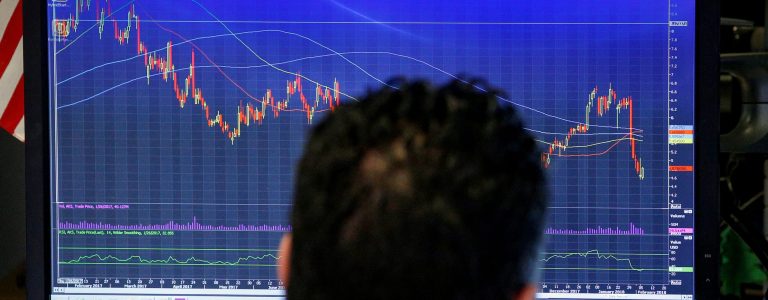The U.S. has detonated across markets worldwide. Yields on 10-year Treasury bonds sagged, the dollar weakened, and the S&P 500 and Nasdaq Composite indexes slumped 4% in New York morning trading a day after President Donald Trump unveiled a bewildering array of levies on imported goods. Combined, they imply an aggregate effective rate beyond 20%, its highest in a century by many estimates. The question now is whether Washington will get the message from Wall Street.
The White House professes to no longer react to stock-price gyrations. Treasury Secretary Scott Bessent, for example, has said repeatedly that the administration cares more about indicators that reflect the “real economy,” namely the strength of the currency and how much the U.S. government pays to borrow for a decade. Slumping equities are a “Mag7 problem, not a MAGA problem,” Bessent said on Wednesday, referring respectively to the so-called Magnificent 7 big technology companies and Trump’s own Make America Great Again slogan.
By his preferred measures, the dollar weakened to its lowest level of the year against a basket of other currencies while 10-year Treasury yields slipped to about 4%, down from 4.8% in January, shortly before Trump took office. For the president to backpedal, it seems, will take a bigger panic. When U.S. lawmakers resisted passing a bailout of banks in September 2008, benchmark stock indexes fell 7%. Capitol Hill and George W. Bush’s White House reacted by passing the giant , which provided needed capital and liquidity to an unmooring global financial system.
Congress has the power to step in now, too. The president is using specious emergency authorities to impose tariffs, even though trade deficits have been a feature of a growing U.S. economy for decades. National security is not under threat, even from the harmful drug trafficking that Trump uses as a half-baked excuse to justify his outsized use of executive power. Democrats and a small band of Republicans started to push back, slightly, on Wednesday by passing a measure in the Senate to on Canada. It has little chance, however, of making it through the House of Representatives and becoming law.
Most Republicans have so far been cowed by Trump, but they may be more emboldened as a wide range of constituents and companies seek relief. The American system of checks and balances relies on “ambition … to counteract ambition,” according to James Madison, the former president who helped author the U.S. Constitution. Some of Trump’s prevailing bluster will be sapped by the bruising loss in Wisconsin’s judicial election this week and narrower-than-expected margins of victory in ballots for two Florida congressional seats. The GOP will be increasingly nervous about losing control of Congress next year.
Thermostatic opinion in the United States, a political science phenomenon where the party out of power gains in popularity simply by not being in power, has come for trade policy, too. More than 80% of Americans responding to a in March, a 20 percentage-point increase from last year, said they consider foreign trade an opportunity for economic growth, while those who see it as more of a threat to the U.S. economy dropped by half, to 14%.
Shoppers and businesses were already spooked, even before the news that the cost of many items is bound to rise significantly because of higher U.S. tariffs and the anticipated retaliatory ones from other countries. The University of Michigan’s index of fell to 57 in March, its lowest level since 2022, from about 65 in February. The yardstick of fear among investors, the CBOE Volatility Index, surged past 28 on Thursday, well above its 10-year average.
When holders of capital freak out over policy, lawmakers typically correct course. Multiple market-feedback mechanisms are now signaling that Trump’s tariffs will badly hurt the economy and undercut prosperity. The longer the message is ignored, the harder the damage will be to reverse. Protectionist U.S. trade programs in the 1930s took decades, and a world war, to unwind. Only Congress can stop the president’s misguided attempts to remake the global order for the worse, but it will require listening to the investing and voting masses instead of the Oval Office.
Context News
Stock prices tumbled on April 3, a day after President Donald Trump unveiled sweeping new U.S. global tariffs with a minimum rate of 10%. The S&P 500 Index and Nasdaq Composite Index were both down about 4% at 1030 EDT. Apple’s share price fell 8% because of higher levies on China, the base for much of its iPhone manufacturing. The CBOE Volatility Index, regarded as a gauge of investor fear, reached 27.4 points, higher than its 10-year average. All tariffs imposed by the United States under Trump, and the announced retaliation measures by other countries, imply an increase in the average aggregate effective rate of nearly 20 percentage points, to about 22.5%, the highest since 1909, according to the non-partisan Budget Lab at Yale.


